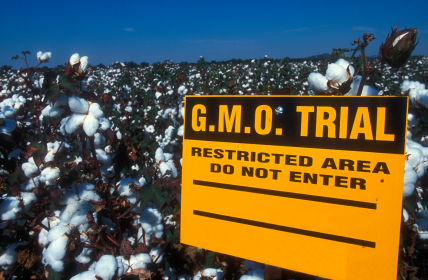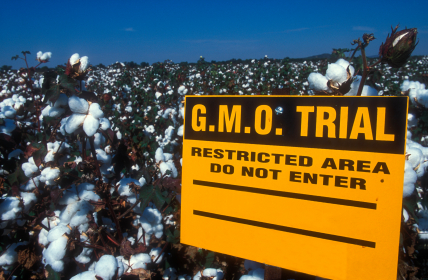 Even as it bombards the airwaves and magazine ad pages to tout its commitment to “sustainable agriculture,” GMO seed giant Monsanto has been having a rough go on the PR front of late.
Even as it bombards the airwaves and magazine ad pages to tout its commitment to “sustainable agriculture,” GMO seed giant Monsanto has been having a rough go on the PR front of late.
First came a report (PDF) from the Organic Center showing that the company’s core Round Up Ready products have sparked a veritable monsoon of herbicide use. According to the report, since the introduction of “herbicide tolerant” corn, soy, and cotton in 1996, farmers have sprayed 382.6 million more pounds of herbicides than they otherwise would have–the overwhelming bulk of it Monsanto’s “Roundup” brand glyphosate.
And the gusher is only growing larger. As farmers have come to increasingly rely on Roundup applications, glyphosate-resistant superweeds are spreading–inspiring farmers to both spray more Roundup and add other toxic chemicals to create herbicide cocktails. “Herbicide use on [herbicide-tolerant] crops rose a remarkable 31.4% from 2007 to 2008,” the report states.
Now that’s sustainable agriculture!
Meanwhile, Monsanto’s dominance over the GMO seed market–and thus over U.S. corn, soy, and cotton production–has become so intense and obvious that “U.S. Department of Justice lawyers are seeking documents and interviewing company employees about its marketing practices,” AP reports.
The DOJ is also gearing up for a public workshop on competition in the seed industry, to be held in Iowa next March 10. The workshops, designed to hear farmer concerns over consolidation in the agriculture industry, will be co-directed by the Department of Agriculture. If U.S. authorities actually did crack down on companies that use their market power to squeeze farmers, it would would mark an epochal shift in antitrust policy, as Barry C. Lynn shows in this classic 2006 Harper’s essay.
Monsanto execs better hope that DOJ lawyers don’t get their paws on a devastating recent report (PDF) from the Farmer-to-Farmer Campaign of Genetic Engineering.
The report establishes two facts that would, under any reasonable criteria, force the DOJ to take antitrust action: 1) Monsanto utterly dominates the market for GM traits in corn, soy, and cotton; and 2) it is using its market power to raise prices to farmers and limit their access to non-GM seeds.
To make a long story short, Monsanto supplies proprietary traits to 85 percent of corn planted in the United States, and 92 percent of soy. Corn and soy are the lifeblood of the U.S. food system. If you eat a standard diet, you’re ingesting a Monsanto-originated product with just about every bite you take.
Nor is the company a benign monopolist, the report shows. GMO corn seeds have jumped from $110 per unit in 1999 to upwards of $190 by 2008; for soy, prices soared from less than $25 to more than $40. A huge portion of those jumps can be explained by the so-called “technology fee”–the price Monsanto charges for its proprietary traits. For Roundup Ready soy, the fee has tripled since 2000. As the report puts it:
This means a farmer who plants one bag of Roundup Ready soybeans per acre on 1,000 acres of soybeans has seen his production costs rise by $11,000 in five years due to the trait price increase alone.
Microsoft, in all of its ’90s-era brazenness, never dreamt of such price hikes for operating system software.
The report brims with testimony from farmers and small seed-company owners bristling against Monsanto’s massive market power. “I feel like a puppet in a string,” one seed owner says.
That sentiment is echoed in an excellent investigative report by Associated Press’ Christopher Leonard. The story’s opening paragraph says it all:
Confidential contracts detailing Monsanto Co.’s business practices reveal how the world’s biggest seed developer is squeezing competitors, controlling smaller seed companies and protecting its dominance over the multibillion-dollar market for genetically altered crops, an Associated Press investigation has found.
With all of this information on the table and circulating in the public record, DOJ lawyers will have a hard time avoiding a showdown with Monsanto over its practices.
Yet Monsanto is so powerful and well-connected that it just might skate free of antitrust trouble. To gauge whether a publicly traded company faces a real threat from outside forces like antitrust issues, I check in with how its stock is faring. Monsanto’s stock price (chart) is actually up about 10 percent over the last month–evidence that investors think that the DOJ investigators are pussycats and that the company can continue imposing higher prices on farmers.
Let’s hope the “smart money” is wrong. Monsanto itself seems to be taking the threat somewhat seriously. The Iowa Independent reported two weeks ago:
As the U.S. Departments of Justice and Agriculture gear up for an unprecedented series of investigative workshops on agricultural competition and regulatory issues, a Des Moines law firm with deep political ties has signed on to represent agribusiness giant Monsanto.
The Independent reports that the firm has signed a lobbying contract with Iowa lawyer and politico Jerry Crawford–a long-time friend and financial supporter of USDA chief and former Iowa governor Tom Vilsack:
In addition to supplying the Vilsack campaigns (1998 to 2002) and Heartland 527-PAC [Vilsack’s political-action committee] with more than $150,000 in donations, Crawford was listed as the Heartland PAC treasurer on documents filed with the Internal Revenue Service. He also served on the board of directors for the Democratic Governors Association, and has been called “one of the leading Democratic strategists in Iowa.” Crawford has been chairman of the Polk County Democratic Party, and has served as state chairman or legal counsel for presidential campaigns in Iowa for nearly as long as the state’s first-in-the-nation caucuses have held influence.
Meanwhile, there also recently came a cold slap to one of Monsanto’s most hyped promises: that it will soon deliver genetically engineered corn, rice, and wheat strains that demand much less nitrogen fertilizer. Nitrogen fertilizer is a major ecological liability of industrial agriculture–synthetic nitrogen pollutes streams and blots out fish life, destroys soil organic matter, and enters the atmosphere as nitrous oxide, a greenhouse gas 300 times more potent than carbon.
In a recent report (PDF), the Union of Concerned Scientists’ Doug Gurian-Sherman pointed out that thus far, the GM crop industry has had zero success at engineering crops with “complex traits” like improved nitrogen efficiency.
Splicing in a gene that makes corn tolerate a certain herbicide is one thing; improving a highly complex, multi-gene, not-completely-understood process like nitrogen efficiency is completely different. Despite all the hype around nitrogen-efficient GM corn, the GM seed giants are conducting relatively few trials to test crops in the field, Gurian-Sherman reports.
“Although a few genes that appear promising for improving NUE [nitrogen-use efficiency] have been identified in the public literature, they have yet to demonstrate that they can improve consistently in various environments, and without significant undesirable side effects that could harm our agriculture, environment, or public health,” Gurian-Sherman writes. Meanwhile, other methods of reducing nitrogen use, like traditional breeding and ecosystem approaches, have proven track records.
Gurian-Sherman is also the author of another report this year that shattered one of Monsanto’s most cherished myths: that GM technology increases yields. Actually, it does nothing of the sort.



